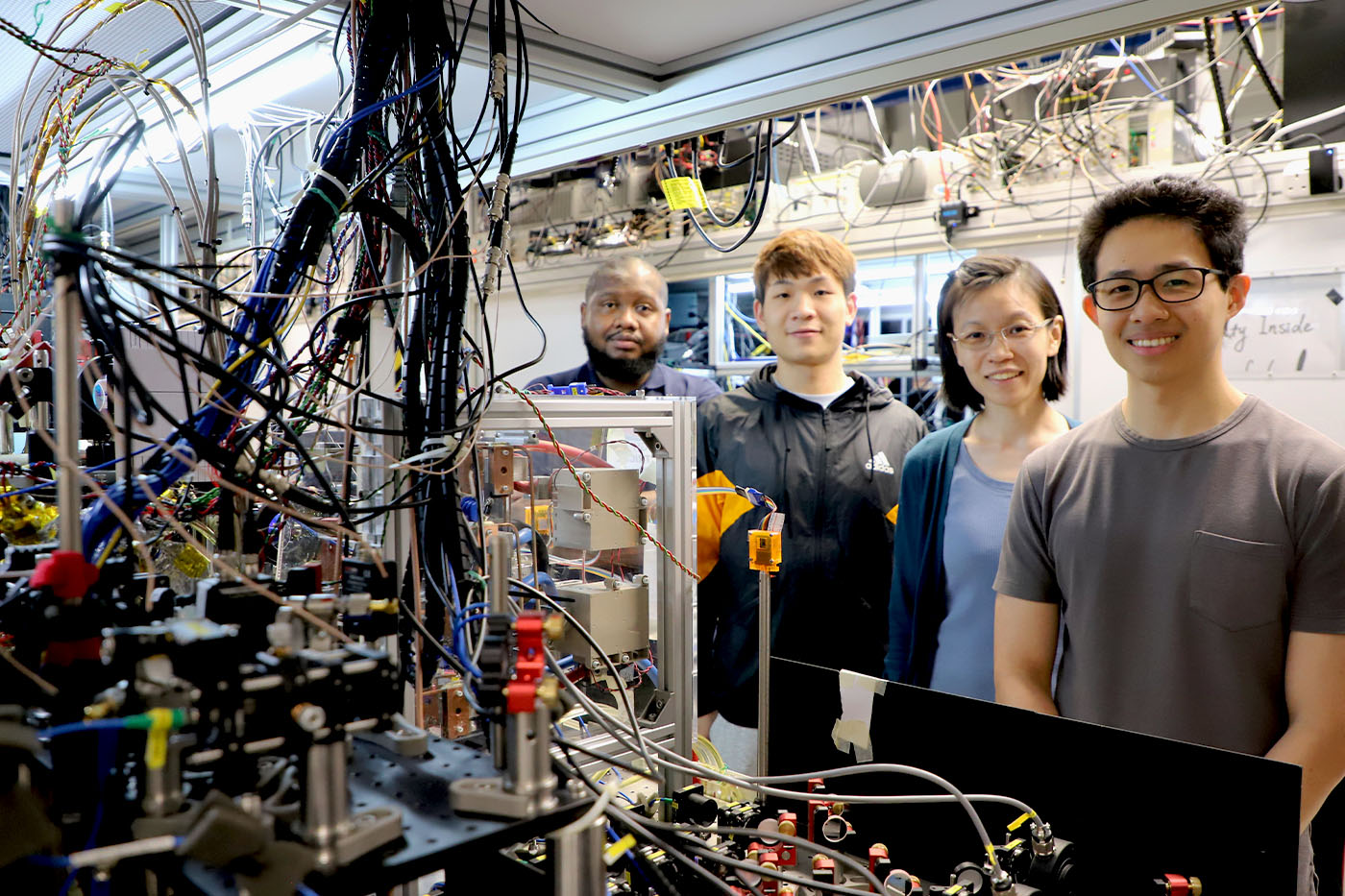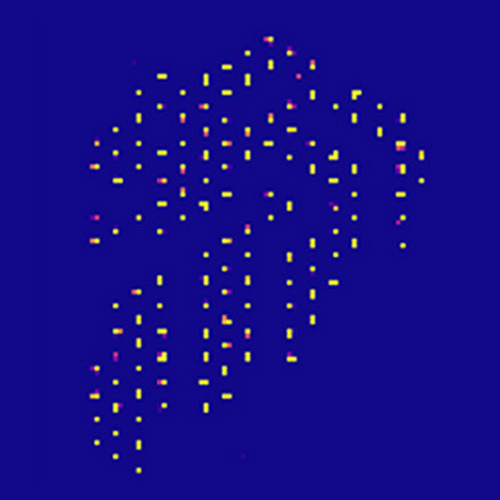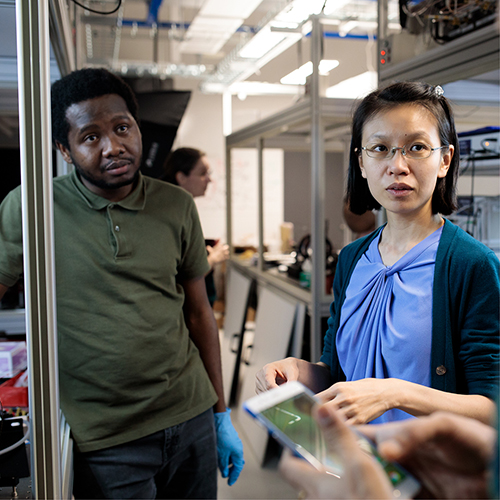Highlights
Qubits get new entanglement options in promising quantum computing platform
 (From left) CQT’s Mohammad Mujahid Aliyu, Zhao Luheng, Loh Huanqian and Michael Lee Dao Kang with their experimental setup. They report a new technique that brings three advances to neutral atom arrays, a promising platform for quantum computing and simulation. The approach can extend the entanglement range, protect entangled states and initialise strongly-interacting states.
(From left) CQT’s Mohammad Mujahid Aliyu, Zhao Luheng, Loh Huanqian and Michael Lee Dao Kang with their experimental setup. They report a new technique that brings three advances to neutral atom arrays, a promising platform for quantum computing and simulation. The approach can extend the entanglement range, protect entangled states and initialise strongly-interacting states.
CQT researchers have overcome a supposed distance limit on generating entanglement in neutral atom arrays. This means qubits in the promising quantum computing platform can be connected in more ways than before, boosting the options for information processing.
For example, the extended entanglement range demonstrated by the CQT team would allow atoms arranged in a square grid to be linked across diagonals as well as to nearest-neighbours. This could make it easier to perform calculations.
Their novel technique not only paves the way for realising more connected neutral atom processors, but can also make them more coherent and tuneable.
“Our approach is not just a tool,” says CQT PhD student Zhao Luheng, who is first author on the paper describing the results. “It is really new physics because we break out of this constraint and open a lot of new doors we can explore.”
His paper with fellow CQT PhD student Michael Dao Kang Lee, newly minted CQT PhD graduate Mohammad Mujahid Aliyu and Principal Investigator Loh Huanqian is published in Nature Communications on 6 November 2023.
Breaking through blockade
There is growing interest in neutral atom arrays as platforms to build quantum computers of the future and for carrying out quantum simulations of other systems. Some companies are pursuing the technology even as academic groups develop new techniques.
To use neutral atom arrays for quantum simulation and computation, researchers conventionally create what are called Rydberg states. Rydberg atoms have one electron in a highly excited state and interact strongly with each other.
The precise spacing of the atoms affects these interactions. Within what’s known as the ‘Rydberg blockade’ radius, two neighbouring atoms interact so strongly that only one can be excited to a Rydberg state. In this Rydberg blockade regime, researchers can entangle the two atoms and perform gate operations useful for quantum computing. It works because the atoms are coupled so strongly to each other that the excitation laser is no longer on resonance.
The CQT team extends the radius with their technique, ‘Floquet frequency modulation’ (FFM). This involves using an acousto-optic modulator to modulate the frequency of the excitation laser. This modulation adds extra frequency tones, which can be tuned at will.
For instance, the extra tones can be made to interfere and bring the excitation laser off resonance even in the case of weak atom-atom coupling. This effectively enforces the Rydberg blockade for two atoms spaced farther than the usual blockade radius, which the researchers used to demonstrate an enlarged entanglement range.
 The CQT team trapped two sodium atoms using ‘magic wavelength’ optical tweezers and excited them to Rydberg states in their experiment. Here is a close-up view of their experimental setup.
The CQT team trapped two sodium atoms using ‘magic wavelength’ optical tweezers and excited them to Rydberg states in their experiment. Here is a close-up view of their experimental setup.
The technique can also be applied in reverse to prepare strongly-interacting states. Although two atoms spaced closer than the usual blockade radius typically cannot be simultaneously excited to Rydberg states, FFM can help. The researchers used FFM to tune the extra frequency tones into resonance with the strong atom-atom coupling. This makes it more likely to excite both atoms, which is known as the anti-blockade regime. Arrays in the anti-blockade state are promising for quantum simulations of dynamics such as that of epidemics and of flat band systems in condensed matter physics.
“This breaks our conventional intuition of when to expect Rydberg blockade versus anti-blockade behaviour,” says Huanqian.
Better protection
That’s not all. Like other quantum computing platforms, atom arrays suffer from decoherence that degrades the atoms’ entanglement. Where they can generate entangled states, the researchers make a third discovery: FFM can also protect the entanglement.
In their work, the researchers compare FFM to a laser-free scheme, where the laser is turned off after generating the entangled states. They observe that the entangled states decohere less quickly in the FFM scheme.
Why? Trapped in an array, the atoms still have a small velocity. This makes the atoms see the frequency of the laser differently because of their movement, an effect known as Doppler shift. The modulation of the laser in FFM minimises the impact of the Doppler shift.
Having focused their experiment on two atoms, the researchers now want to use FFM in a larger array. “We can try a lot of new things that were previously forbidden,” says Luheng.
Learn more
Related Stories
 | Many tweezers make light work of atom-array assembly March 16 2023 |
 | CQT researchers land on a magic wavelength for scaling atomic arrays November 01 2021 |






